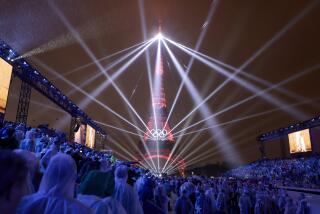SATELLITES POISED AS A BRIDGE OVER CONFLICT
- Share via
Leaders of six nations are expected to participate Saturday in an unusual television event demonstrating that the high frontier of space may be a platform for world peace as well as world war.
If all goes according to plan, the government heads will join in what is believed to be the first interactive television broadcast to originate simultaneously from the continents of North America, South America, Africa, Asia and Europe. Audiences and participants on each continent will see and hear one another as the world leaders, creators of the Five Continent Peace Initiative, receive the 1985 Beyond War award for their joint effort to end the threat of nuclear annihilation.
The logistics of the TV venture make up “an immense game of chess,” said Mel Swope, executive producer of event, which he has dubbed the “spacebridge.” The program will be transmitted to 157 sites across the United States, including the Los Angeles Scottish Rite Temple (4357 Wilshire Blvd.) begining at 8 a.m. The event is open to the public for a $10 donation. There may be a public-broadcasting special of the event next year, Swope said.
The production, Swope estimated, will cost more than $500,000, all of it donated to the Beyond War Foundation, an 8,000-member educational movement aimed at convincing people that all war is obsolete. It was founded three years ago in Palo Alto, Calif., and began presenting its Beyond War award in 1983. The award, $10,000 and a 14-inch column of lead crystal designed by Steuben Glass, previously has been presented to the Catholic Bishops of the United States and to International Physicians for the Prevention of Nuclear War, which earlier this week was awarded the Nobel Peace Prize in Oslo.
The winners of the Beyond War award include President Raul Alfonsin (Argentina), Prime Minister Rajiv Gandhi (India), President Miguel de la Madrid (Mexico), First President Julius Nyerere (Tanzania), Prime Minister Olof Palme (Sweden) and Prime Miniter Andreas Papandreou (Greece). Earlier this year, they issued a worldwide call for a rethinking of “traditional doctrines of war in a world where new weapons have made them obsolete.”
Uniting the winners for the awards ceremony will be the 10-satellite spacebridge, 4-million miles of signal paths that may as well have been plotted by Rube Goldberg.
Earlier this week, producer Swope was still negotiating for satellite time in some distant reaches of the globe. He was trying to work around a soccer match in Africa that had booked one of the satellites necessary for the broadcast.
“Each day, there’s been a new hitch,” Swope said. “Africa has turned out to be a very difficult place to get to.”
Even when the problems of access have been overcome, the logistics of bouncing TV signals around the world have been awesome.
Pictures of Gandhi from New Delhi will arrive at the site of the principal ceremonies at the Masonic Temple in San Francisco by passing to a satellite earth station. It will transmit the signal to an international communications satellite in geosynchronous orbit about 22,300 miles above the Indian Ocean. That satellite will bounce the signal back to an earth station at Yamaguchi, Japan, which will send the signal along to another international transmitter in Ibaraki, Japan, for relay to another satellite in orbit above the Gilbert Islands in the Pacific.
The signal will touch Earth again at a remote satellite receiving station near Jamesburg, Calif., and shoot back to a domestic satellite for relay to San Francisco. The last mile or so to the Masonic Temple in downtown San Francisco will be handled by traditional microwave relays.
The entire trip will take three to six seconds.
An ambitious undertaking for any group, Beyond War’s spacebridge is unusual even by the standards of modern broadcasting. ABC’s “Nightline,” for example, often conducts live interviews with news makers or foreign leaders on other continents, but there rarely is a two-way video connection between program host Ted Koppel and his interview subject.
In the same manner, multinational corporations also often put together elaborate communications links for meetings among offices spread around the world. According to AT&T; Communications officials, however, these corporate teleconferences rarely are as ambitious as Swope hopes to be with his spacebridge. Nor, he added, do they reflect the degree of video production expertise that he plans for Saturday’s program.
“This is a major production,” he said. “It’s much more sophisticated than a board of directors meeting.”
More to Read
Sign up for Essential California
The most important California stories and recommendations in your inbox every morning.
You may occasionally receive promotional content from the Los Angeles Times.













